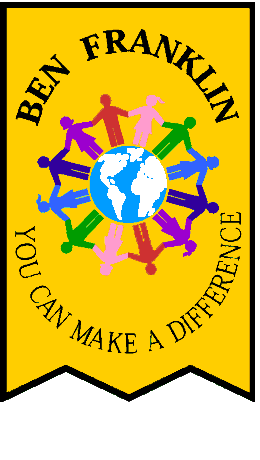

The Benjamin Franklin Elementary School Physical Education Department
believes that the guiding principle behind the physical fitness
evaluation process is to help all children see the value of
regular activity and adopt a lifelong routine of exercise.
This can only be accomplished by enlisting all members of the family
to support lessons taught in our gymnasium. These lessons
focus on the development of a positive attitude towards healthy
living.
An area of national concern is the lack of physical
fitness among children. Recently, the President's Council
on Physical Fitness and Sports issued a report showing that American
youth showed no improvements, and in some cases showed a decline,
in physical fitness since 1976. The American Academy of Pediatrics,
voicing this same concern, reported that less than one third of
today's youth are involved in programs designed to develop and understanding
of the benefits of exercise or the fitness skills necessary to develop
healthy hearts and lungs.
We have chosen to use the components of the President's
Challenge Physical Fitness Program to assess fitness levels for
all students in grades 1-5. This battery has designed to
provide valuable physical fitness information that should be used
in developing an individualized program of activity focused on
improving your child's physical fitness levels. We will be testing
the students through the course the year. In addition
we believe that they should be receiving knowledge on how their body
works.
| Circulatory System |
Muscular System |
Skeletal System |
Nutrition
|
Internet Project Options
(using Web Quests) |
10 Fitness Stations which will include muscular strength, endurance, and flexibility. Each student will go to every station for 1- 3 minutes at each station in groups of 4-5 students /station. After all the stations are completed students will go outside for practice runs for the Presidential Fitness Run. Stations for muscular endurance will include: jump ropes, Agility Ladder, Steps like step aerobics, scooter pull. Stations for muscular strength will include: Dumbbells (2-5 lbs.), / or dynabands, flexed arm hang/ pull-ups, and Crunches. There will also be a water / rest station The stations for muscular flexibility will include: stretches (Straddle, Pike and Calf) sit-n-reach box. Computer Station topic is on the circulatory system (Heart, arteries, veins and blood) using the following web sites:
At this site we had three separate window opened for each of the following Cardiovascular System, Heart (Cut View) and Capillary. This web site shows the students the flow of blood through the body, the heart, and the capillaries. Using the slide on the bottom you can make the blood flow faster or slower.
On this site we asked the students to decide as a group which heart beat sounded like a resting heart rate, working heart rate, or recovery heart rate
DAY 2
There will be 10 stations setup in the gymnasium. Each
student will go to every station for 1- 3 minutes at each station in
groups of 4-5 students /station. After all the stations are
completed students will go outside for practice runs for the Presidential
Fitness Run. The stations included: jump rope scooter pull,
step ups, crunches, flexed arm hang, ddumbbellcurl where students do
do lateral raises rather than biceps curls, the aagility ladder will be
replaced with a 10 yard sprint or shuttle run, stretches
(Straddle, Pike and Calf) sit-n-reach box, a water /
rest station, Computer Station using the following web sites:
Human
Body Adventure - Cardiovascular System
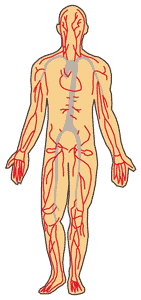
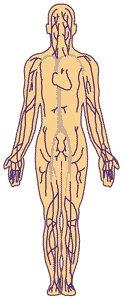
On this site the students tried to answer the questions online, and
when class ended they were giving a Word Search Page
& List of Words Page for homework. This homework was due 2 weeks
later, and was put into their portfolio after looked at by a teacher.

DAY 1
There will be 10 stations setup in the gymnasium. Each
student will go to every station for 1- 2 minutes at each station in
groups of 4-5 students /station. After all the stations are
completed students will go outside for practice runs for the Presidential
Fitness Run. New stations include 1. Low Hurdles - two foot
jumps over a series of 5 hurdles plyometic banana hurdles, 2. Body Bar
Curl 9 lbs., 10 yard shuttle sprint - timed by partners. The remaining stations
are the same as before: flexibility, ,step-ups crunches, scooter pull, jump
rope, flexed arm hang. These remain the same to allow time to practice
the Presidential Run.

DAY 2
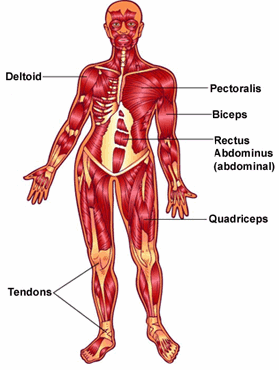
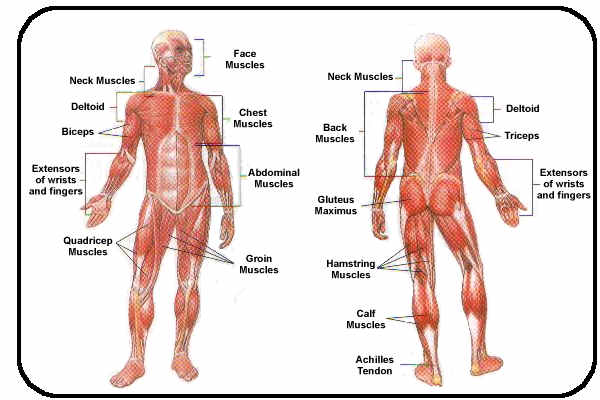

This web site shows the students the Nerve/Muscle Connection, and the sarcameres contract, while the arm raises and lowers a slice of pizza. Using the slide on the bottom you can make the muscle contract faster or slower.
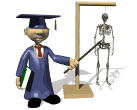
DAY 1
There will be 10 stations setup in the gymnasium. Each
student will go to every station for 1- 2 minutes at each station in
groups of 4-5 students /station. After all the stations are
completed students will go outside for practice runs for the Presidential
Fitness Run. New stations include 1. Medicine Ball Toss (3
kg.), 2. Standing Long Jump, and 3. Vertical Jump. The remaining stations
are the same as before: flexibility, ,step-ups crunches, Body
Bar Curl 9 lbs, jump rope, flexed arm hang. These remain
the same to allow time to practice the Presidential Run.

DAY 2


|
Skeletal
System - What is its function? |

|
Broken
Bones - How they heal? |

|
Bone
Structure - What are bones for?
|

|
Joints
- How do bones in a skeleton move? |

|
Spinal
Cord - What does the spinal cord do |

This web site reminds lets the student place the arrow on a bone and
see the scientific name of the bone For homework the students were giving
a copy of this skeleton and they were required to label as many bones
as they could. Just like the muscle of the day theme, we started bone of
the day theme too.
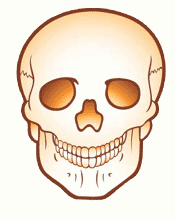
This web site has a 4 page article. Here we used page 3
of the article so students knew how to pronounce the names of the bones.
Today after class we also gave the students a copy of the picture
on this web site with all the muscles whited out skeleton homework.

Nutrition
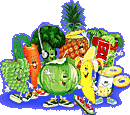

This web site will allow one computer to view 2 separate
movies all day, but if you sign off you can not see anymore with out
buying a membership. However, I have found that as long as I kept
the computer up and never closed the page, I could watch 1 movie all day.
Test it out for your self and see what works. The site BrainPop.com
will have a 90 second movie clips on the following

|
Nutrition
- What type of food is health for you to eat? |

|
Body
Chemistry - Why do we need to eat and drink? |

|
Fitness
- Is it necessary to exercise everyday?
|

|
Your
Body - How does my body work? |

|
Growth
& Genetics - How fast does your body grow? |
Internet Project Options (using Web Quests)

TrackStar helps instructors organize and annotate Web sites (URLs)
for use in lessons. The resource list remains visible allowing the user
to easily stay on track.
Track Description: Gives students the opportunity
to work in groups and research Obesity.

A group of parents are concerned about the potential drug use by our Naperville Central students. They have contacted the Health teachers and asked that our students create presentations that would be useful in deterring our freshman from drug use. Each group will research one category of drugs. Your group will then make a powerpoint presentation that would be interesting, informative and appropriate for Naperville Central freshman students. Each group will examine one of the following drug categories;
Alcohol Stimulants
Cannabis/Marijuana Performance Enhancing Drugs
Hallucinogens Sedative-hypnotics or Depressants
Inhalants Designer Drugs
MDMA Narcotics
The following sites may be useful for health related
research

You will assess your physical wellness by analyzing your diet, exercise
patterns and family health history. This project requires internet access,
if you don’t have access at home, use the CAI lab on your lunch period
or study hall. Anytime you use the internet you may run into snags. Do
your best to work through the snags, then ask your classmates and teacher
for assistance.
Website Health was created as a self-study course designed to improve
your personal health. Students of this course begin by assessing their
current level of health, then create a personalized course of study based
on the assessment results.
It is hoped that the result of this course is not only a better understanding
of one's health, but healthier behaviors as well.
Be Well!!
Grades
9-12 Health/PE WebQuests
|
|
Some say that Substance Abuse is a matter of choice, that you can just say "No". Others claim that it is a disease, that you inherit a predisposition to addiction. Which is it? |
|
Design a fitness program for a client. |
|
|
Use mathematical concepts to evaluate the hockey players of National Hockey League teams. |
|
|
Research different eating disorders and come up with a strategy to help someone overcome an eating disorder. |
|
|
Students learn about structure, function and medical importance of a part of the body and write a report similar to the "I Am Joe's" and "I Am Jane's" series of articles published in Reader's Digest in the 1970's. |
|
|
Create an anti-smoking campaign for teens. |
|
|
You are members of a special task force convened by the National Board of American Coaches (NBAC) to stop further heatstroke deaths in sports. |
Grades
6-8 Health/PE WebQuests
| Research sites about games and design a
new one. |
|
| March
Madnesss |
Analyze the statistics leading up to the
NCAA Basketball championship games. |
| The
Dilemma of the Dangerous Meatloaf |
Students determine and defend a position
on the healthfulness of a food through analysis/research |
| This Mission
is Possible |
Become a camp counselor and develop a healthy
menu, exercise program, and brochure. |
Elementary School Projects
Grades
3-5 Health/PE WebQuests
| Learn about what constitutes a complete
and nutritious breakfast, and what strategies advertisers use to market
breakfast foods to children. |
|
| Summer 2000
Olympics |
Learn about the athletes and individual
sports of the summer olympics by scripting an interview with an athlete
or a fan. |
| Create
an Athlete |
In this activity, students learn about the
athletic training, fitness, nutrition, sportsmanship, and other factors that
contribute to the development of an Olympian. Students use the knowledge
they've acquired to create a fictitious athlete using the online form and
publish their athletes to the site. |
| Co-nexercise |
How fit are your students? How much can you
exercise in one week? During Co-nexercise Week, May 7-14, students track
the amount of time they exercise and compete virtually with other classrooms
across the country. |
![]()